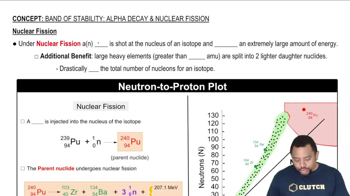Here are the essential concepts you must grasp in order to answer the question correctly.
Nuclear Fission
Nuclear fission is a process in which a heavy nucleus, such as U-235, splits into two smaller nuclei, along with the release of energy and neutrons. This reaction can be initiated by the absorption of a neutron, leading to the formation of fission products like Ba-140 and Kr-93. Understanding this process is crucial for calculating the amounts of products formed in a fission reaction.
Recommended video:
Band of Stability: Nuclear Fission
Stoichiometry
Stoichiometry involves the calculation of reactants and products in chemical reactions based on the conservation of mass. In the context of fission, it allows us to determine the moles of U-235 consumed and the corresponding moles of fission products produced. This is essential for converting the mass of U-235 into the volume of Kr-93 produced.
Recommended video:
Ideal Gas Law
The Ideal Gas Law (PV = nRT) relates the pressure, volume, temperature, and number of moles of a gas. It is used to calculate the volume of gases under specific conditions. In this question, it will help determine the volume of Kr-93 produced from the moles calculated from the fission reaction, given the temperature and pressure conditions.
Recommended video:
 Verified step by step guidance
Verified step by step guidance

